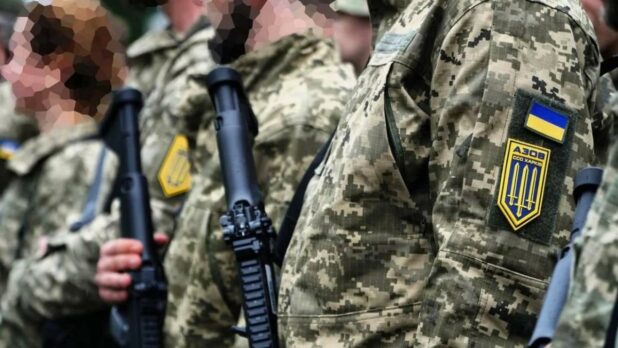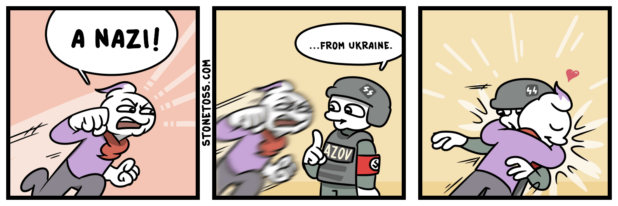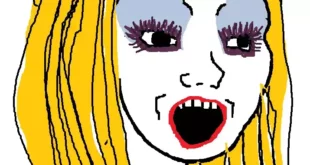The Azov Battalion: now rated PG-13. pic.twitter.com/K0ONI94Lhw
— Kevin Rothrock (@KevinRothrock) May 31, 2022
Having reached the end of the line, having been felted, the Ukraine is doing some very serious brand management. They’ve introduced a totally anal Unicorn Force.
They’re also trying to be slightly less Nazi, in order to appeal to people who are not so Nazi.
This is happening as the Ukraine is trying to form a completely new military from people they’ve just grabbed off the streets in Kiev.
RT:
The infamous Azov nationalist regiment, which is being revived by Ukraine after it surrendered to Russian forces in Mariupol, has removed the Nazi-linked Wolfsangel symbol from its insignia, The Times reported on Monday.
According to the British paper, the unit’s new recruits in the city of Kharkov were sporting patches with a golden trident, which is Ukraine’s national emblem, thereby replacing the Wolfsangel or ‘wolf’s hook’ which had been used by the Azov Battalion since its formation eight years ago.
However, the commander of the new unit, Maksim Zhorin, told that paper that it was formed “on the same principles and ideological basis as the legendary Azov regiment.”
The Wolfsangel is a historic heraldic symbol that was chosen by the Nazis during World War II and appeared on the insignia of several SS divisions.
The Times said that the presence of the Wolfsangel on the uniforms of the Azov fighters had “helped perpetuate Russian propaganda about Ukraine being in the grip of far-right nationalism.”
However, before the launch of the Russian military operation in Ukraine, the use of Nazi symbolism by the unit had been raising concerns in the Western media, including outlets such as Time magazine and the New York Times.
The Azov Battalion was assembled in 2014 as a volunteer unit that was mainly comprised of far-right activists willing to fight against the self-proclaimed republics in the Donbass region. Several months later, it was officially incorporated into Ukraine’s National Guard by order of then president Petro Poroshenko.
I don’t really even understand this.
It’s not like anyone was criticizing the Nazi thing, other than… Nazis on the internet.
Maybe it was getting criticism from the Europeans, who the Ukrainians may be worried they’re being abandoned by. But in American media, the entire narrative was solidly behind Azov, to the point where it is obvious that there is a top-down order to never criticize them.
The other thing about this is: it’s basically an admission that they were Nazis, which goes against the narrative.
I don’t think this really relates to trying to get people more invested in the military domestically. The entire narrative of “Ukraine identity” that the CIA has been building since 2014 has surrounded this “Nazi” Banderite ideology.
Although, maybe the entirety of Azov surrendering has damaged their brand domestically?
Anyway, I’ll say: changing the Azov logo is on par with threatening to invade Moldova in terms of desperation levels.
Hell hath no fury like a Jew felted.
“neo-Nazi symbol exploited” that’s great journalizm by itself.
Btw the “Civil defense units” (CCO) used that symbol for quite a while e.g. in Bucha. No idea if the Azov battalion still exist.— Michael Kobs (@MichaKobs) May 30, 2022
Well, that’s sound really awkward. Taking a symbol down but insisting on “based on the same principles and ideological basis as the legendary Azov regiment”. Be real journalists and tell us what this ideology is about, how this symbol got there in the 1st place. We are curious.
— Bergmeir, Tonie (@BergmeirTonie) May 30, 2022
Neo-Nazis remove neo-Nazi symbol after Russians cite existence of neo-Nazis for justification of removing neo-Nazis? Wow great job guys.
— necroz (@necrozoid) May 30, 2022
Can’t hide what’s underneathhttps://t.co/Cx67Xp7vZh
— Thelma 🇮🇸 (@Urdur) May 30, 2022
Toning down the Nazism since it’s undermining the virtue-signalling.
— david kersten (@davidkersten) May 31, 2022
 Daily Stormer The Most Censored Publication in History
Daily Stormer The Most Censored Publication in History




